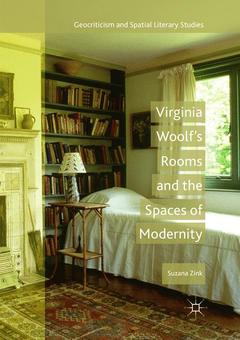Description
Virginia Woolf's Rooms and the Spaces of Modernity, Softcover reprint of the original 1st ed. 2018
Geocriticism and Spatial Literary Studies Series
Language: English
Keywords
spatial imaginary; tropes of rooms; socio-cultural issues; Virginia Woolf; modernist literature; transnational space; flauneuse; urban representations; life writing; autobiography; spatiality; A Room of One's Own; Cheyne Walk; Mary Geraldine Ostle; Jacob's Room; interiority in Virgina Woolf; Night and Day; Between the Acts; class mobility; male and female spaces in Woolf
Publication date: 06-2019
223 p. · 14.8x21 cm · Paperback
Publication date: 02-2018
Support: Print on demand
Description
/li>Contents
/li>Biography
/li>Comment
/li>
This book provides a fascinating account of rooms in selected works by Virginia Woolf. Casting them as spaces which are at once material, textual and emotional, the volume shows Woolf?s rooms to be consistently connected to wider geographies of modernity and therefore central to her writing of gender, class, empire and the nation. The discussion moves ?in and out of rooms,? from the focus on travel in Woolf?s debut novel, to the archival function of built space and literary heritage in Night andDay, the university as a male space of learning in Jacob?s Room, the iconic A Room of One?s Own and its historical readers, interior space as spatial history in The Years, and rooms as loci of memory in her unfinished memoir. Zink masterfully shows the spatial formation of rooms to be at the heart of Woolf?s interweaving of the political and the aesthetic, revealing an understanding of space as dynamic and relational.
1 Introduction.- 2 Re-Reading the Modern.- 3 Out of Rooms: Imperial Routes and the Impasse of Becoming in The Voyage Out.- 4 Night and Day: Great Men’s Rooms and Women’s Lives.- 5 Trespassing: Spaces of Learning in Jacob’s Room.- 6 The Woman’s Room: A Room of One’s Own and Its Contemporary Readers.- 7 Writing Spatial History: The Years.- 7 Rooms of Memory: “A Sketch of the Past”.- 9 Conclusion.
Suzana Zink is Lecturer at the University of Neuchâtel, a position she has held since 2005. Her teaching experience includes both literature and language courses and her research interests focus on space and place in modernism, especially Virginia Woolf and Jean Rhys.
Engages with Virginia Woolf’s fiction, essays, and autobiographical writings
Expands the trope of rooms to look at the intersection between textual, physical, and metaphorical meanings of space
Connects interiority and space with wider geographies of gender, class, and empire
These books may interest you

The Value of Virginia Woolf 35.48 €



